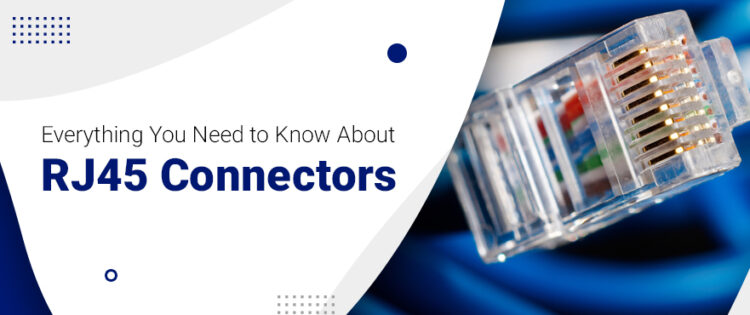The most common place to find an RJ45 Connector is the end of your Ethernet connection. If you look at them for the first time, you will find them very similar to the telephone jacks and plugs that connect landlines to switchboards or walls. However, the RJ45 connectors are usually larger in size. At present, you will find the term RJ45 being widely used to explain both female RJ45 sockets and male RJ45 plugs. Plugs — also dubbed as modular connectors — can be found usually at the end of your Cat5e, Cat6, Cat6a, or Cat7 ethernet cables.
Generally, manufacturers embed the jacks or sockets in the device that is being mounted or hooked to fix a wall panel.
Speaking of the term, RJ45 is an abbreviation for Registered Jack 45 and is part of universally standardized networking infrastructure.
RJ45 Connectors & Wired Ethernet Connections
Despite all the technological advancements in wireless connectivity, wired networking remains the preferred choice as the latter is a more stable, reliable, and interference-free connection. Besides, wired networks are way better than their wireless counterparts when it comes to data transfer rates and security.
Due to the aforesaid reasons, Ethernet networks are usually found in both professional and domestic environments. To put it simply, several devices are interconnected in a network, and these devices share data or connect to worldwide networks through ethernet and fiber optic cables.
If all devices share data through wireless connections, there may be no need for a cable or RJ45 connectors altogether. However, if you are using wired connectivity, then for obvious reasons, you will be using ethernet cables. These cables will be interconnected via a metal plug or small plastic fittings at both ends. Corresponding sockets allow the plug to slot in to make a secure connection. These socket fittings and modular plugs are commonly known as RJ45 connectors.
Types of RJ45 Connector
Usually, the two most common types of RJ45 connectors are Male RJ45 connectors and Female RJ45 connectors. The question is, how can you distinguish between the two?
To put it simply, sockets or jacks are female, whereas plugs are male. The major responsibility of the plug is to terminate the Ethernet cable’s wires properly. On the other hand, the role of the female RJ45 connector or sockets is to transfer the data signals through the device it is being shared with. Male and female connectors have been designed to fit perfectly together to provide a solid connection – both electrical and physical.
Wiring Conventions for RJ45 Connectors
The two wiring conventions for RJ45 connectors are T568A and T568B.
These wiring conventions govern the orders in which you will link the eight individual conductors/wires of an ethernet cable with an RJ45 connector pinout.
Both of these two standards — T568A and T568B — have their own color codes, with the major difference being that the green and orange pairs are swapped around. The right standard depends on the circumstance if you are using a crossover cable or straight-through cable. Usually, you will go with the patch cables. However, when it comes to crossover cables, they have a T568A connection at one end and T568B at the other.
A Step-by-Step Guide to Ethernet Cable RJ45 Wiring
You will need the following tools and components:
An Ethernet cable (Cat5e, Cat6, Cat6a, or Cat7)
RJ45 connectors
And, RJ45 Crimping Tool
After sorting out which wiring convention you will go with, follow these steps to complete your RJ45 wiring:
Begin with cutting your cables to the required lengths. Use a cable cutter for this purpose.
Now pick a crimping tool and trim and tidy the cut ends of the ethernet cable.
Using wire strippers, remove almost an inch of the ethernet cable’s jacket from the end. While doing so, you have to ensure that internal wiring is not damaged.
Separate, untwist, flatten, and straighten the eight conductors as much as possible.
Gently move the arranged wires through the body of the RJ45 plug until they touch the pins of the connector.
Now use a crimping tool to press down tightly on the connector. After crimping, test the cable to find out whether a connection has been established successfully or not. If the connection has been established, your cable is ready for use.




















